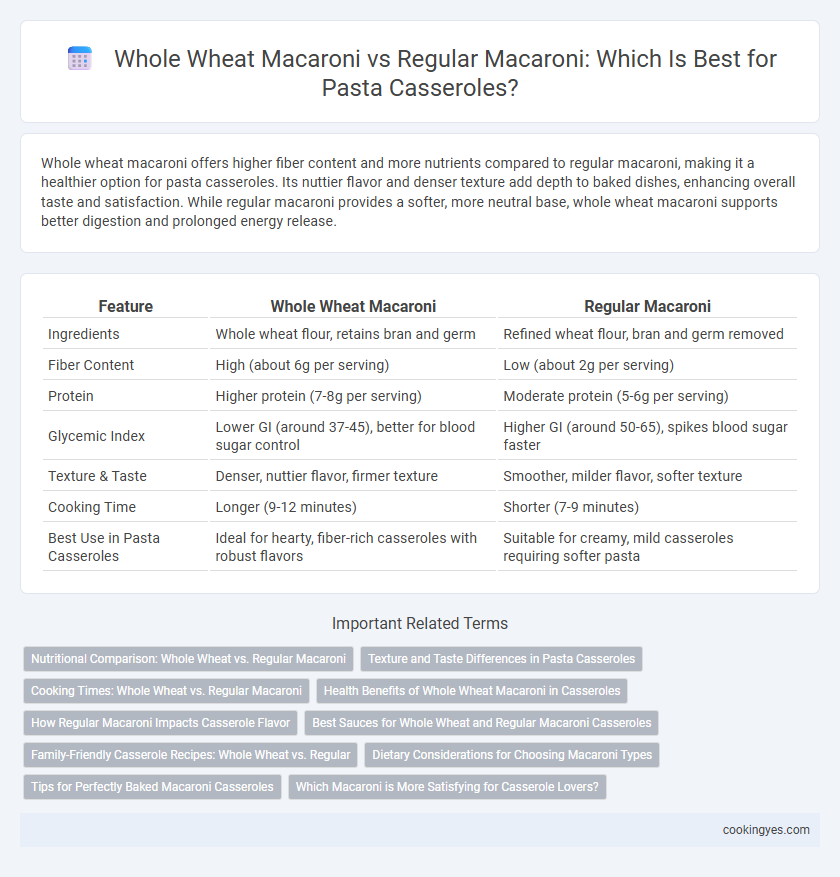Whole wheat macaroni offers higher fiber content and more nutrients compared to regular macaroni, making it a healthier option for pasta casseroles. Its nuttier flavor and denser texture add depth to baked dishes, enhancing overall taste and satisfaction. While regular macaroni provides a softer, more neutral base, whole wheat macaroni supports better digestion and prolonged energy release.
Table of Comparison
| Feature | Whole Wheat Macaroni | Regular Macaroni |
|---|---|---|
| Ingredients | Whole wheat flour, retains bran and germ | Refined wheat flour, bran and germ removed |
| Fiber Content | High (about 6g per serving) | Low (about 2g per serving) |
| Protein | Higher protein (7-8g per serving) | Moderate protein (5-6g per serving) |
| Glycemic Index | Lower GI (around 37-45), better for blood sugar control | Higher GI (around 50-65), spikes blood sugar faster |
| Texture & Taste | Denser, nuttier flavor, firmer texture | Smoother, milder flavor, softer texture |
| Cooking Time | Longer (9-12 minutes) | Shorter (7-9 minutes) |
| Best Use in Pasta Casseroles | Ideal for hearty, fiber-rich casseroles with robust flavors | Suitable for creamy, mild casseroles requiring softer pasta |
Nutritional Comparison: Whole Wheat vs. Regular Macaroni
Whole wheat macaroni offers higher fiber content, providing about 6 grams per cooked cup compared to 2 grams in regular macaroni, which supports better digestion and sustained energy release. It also contains more protein, B vitamins, and minerals like magnesium and zinc, enhancing overall nutritional value for pasta casseroles. Regular macaroni primarily consists of refined flour, resulting in lower nutrient density and higher glycemic index, which may cause quicker blood sugar spikes.
Texture and Taste Differences in Pasta Casseroles
Whole wheat macaroni has a denser texture and nuttier flavor compared to the softer, more neutral taste of regular macaroni in pasta casseroles. The heartier grain in whole wheat absorbs sauces differently, often resulting in a chewier bite and more robust overall flavor profile. Regular macaroni tends to create a smoother, creamier casserole experience due to its lighter texture and milder taste, making it a preferred choice for those seeking a classic pasta casserole.
Cooking Times: Whole Wheat vs. Regular Macaroni
Whole wheat macaroni generally requires a longer cooking time than regular macaroni due to its denser texture and higher fiber content. While regular macaroni typically cooks in 7 to 9 minutes, whole wheat varieties may take 9 to 12 minutes to achieve an al dente consistency. Adjusting cooking times is essential for pasta casseroles to ensure both types maintain optimal texture after baking.
Health Benefits of Whole Wheat Macaroni in Casseroles
Whole wheat macaroni offers higher fiber content and essential nutrients such as magnesium and zinc compared to regular macaroni, promoting better digestion and heart health when used in pasta casseroles. Its lower glycemic index helps regulate blood sugar levels, making it a healthier option for weight management and diabetes control. Incorporating whole wheat macaroni in casseroles enhances nutritional value without compromising on taste or texture.
How Regular Macaroni Impacts Casserole Flavor
Regular macaroni offers a neutral, mild flavor that allows rich sauce and cheese in pasta casseroles to stand out, enhancing the overall taste without overpowering other ingredients. Its tender texture absorbs flavors effectively, contributing to a well-balanced dish. Choosing regular macaroni results in a classic casserole experience marked by harmonious, familiar flavors.
Best Sauces for Whole Wheat and Regular Macaroni Casseroles
Whole wheat macaroni's nuttier, denser texture pairs exquisitely with robust sauces like marinara, chunky vegetable, or creamy mushroom, which complement its hearty flavor and prevent it from becoming overshadowed. Regular macaroni, with its smooth, mild taste and softer bite, works best with classic cheese sauces, creamy Alfredo, or light tomato blends that enhance its delicate profile without overpowering it. Selecting sauces that balance or enhance the pasta's natural texture and flavor ensures a satisfying, harmonious pasta casserole experience.
Family-Friendly Casserole Recipes: Whole Wheat vs. Regular
Whole wheat macaroni offers higher fiber content and nutrients like magnesium and zinc compared to regular macaroni, making it a nutritious choice for family-friendly pasta casseroles. Its denser texture adds a hearty feel, while regular macaroni provides a softer, more familiar bite that appeals to picky eaters. Balancing flavor and health, whole wheat macaroni enhances casserole recipes with added complexity and sustained energy.
Dietary Considerations for Choosing Macaroni Types
Whole wheat macaroni offers higher fiber content and essential nutrients like magnesium and zinc compared to regular macaroni, supporting digestive health and sustained energy release. Regular macaroni, made from refined flour, has a softer texture and milder flavor, which may be preferable for sensitive digestive systems or children. When selecting macaroni for pasta casseroles, dietary goals such as increased fiber intake and glycemic control often favor whole wheat options, while regular macaroni may suit those needing lower fiber or a more neutral taste.
Tips for Perfectly Baked Macaroni Casseroles
Whole wheat macaroni adds a nutty flavor and higher fiber content to pasta casseroles, enhancing both nutrition and texture compared to regular macaroni. To achieve a perfectly baked casserole, pre-cook the pasta al dente to prevent mushiness and mix it with a creamy sauce that binds the ingredients without drying out. Use a combination of cheese and breadcrumbs on top to create a golden, crispy crust while keeping the interior moist and flavorful.
Which Macaroni is More Satisfying for Casserole Lovers?
Whole wheat macaroni offers a richer fiber content and a nuttier flavor, enhancing the texture and nutritional profile of pasta casseroles compared to regular macaroni. Regular macaroni provides a softer, more neutral base that absorbs sauces evenly, making it a classic favorite for creamy and cheesy casseroles. Casserole lovers seeking a heartier, more filling meal often find whole wheat macaroni more satisfying, while those prioritizing a traditional, smooth texture prefer regular macaroni.
Whole wheat macaroni vs Regular macaroni for pasta casseroles Infographic

 cookingyes.com
cookingyes.com